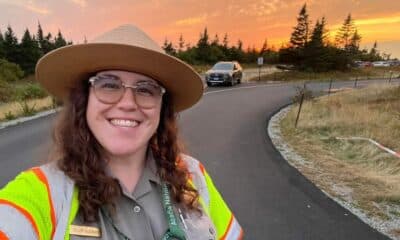Kaiser Health News
People With Disabilities Hope Autonomous Vehicles Deliver Independence
Tony Leys
Tue, 12 Dec 2023 10:00:00 +0000
GRAND RAPIDS, Minn. ― Myrna Peterson predicts self-driving vehicles will be a ticket out of isolation and loneliness for people like her, who live outside big cities and have disabilities that prevent them from driving.
Peterson, who has quadriplegia, is an enthusiastic participant in an unusual test of autonomous vehicles in this corner of northern Minnesota. She helped attract government funding to bring five self-driving vans to Grand Rapids, a city of 11,000 people in a region of pine and birch forests along the Mississippi River.
The project’s self-driving vans always have a human operator in the driver’s seat, poised to take over in complicated situations. But the computers are in control about 90% of the time, and they’ve given 5,000 rides since 2022 without any accidents, organizers say.
“It’s been fun. I’m really sold on it,” said Peterson, who used to rely on her power wheelchair to travel around town, even in winter.
Autonomous vehicles, which can drive themselves at least part of the time, are making news in urban areas, such as San Francisco, where extensive tests of the technology are underway.
Rural experiments have been set up in a few other states, including Iowa and Ohio. Peterson hopes the pilot projects help bring a day when fully autonomous cars and vans assist the estimated 25 million Americans whose travel is limited by disabilities.
Fully independent vehicles remain far from everyday options, as tech companies and automakers struggle to perfect the technology. Recently, for example, General Motors recalled all its self-driving cars after one struck and dragged a pedestrian who had been hit by another vehicle.
But Waymo, a corporate relative of Google, is forging ahead with fully autonomous taxi rides in multiple cities.
Peterson is among those who believe autonomous vehicles someday will become safer than human-driven models.
“Look at how many times the lightbulb failed before it worked,” she said.
Unlike many smaller towns, Grand Rapids has public buses and a taxi service. But Peterson said those options don’t always work well, especially for people with disabilities. The autonomous vehicle program, known as goMARTI, which stands for Minnesota’s Autonomous Rural Transit Initiative, offers a flexible alternative, she said. She hopes it eventually will ease a national shortage of drivers, which tends to be especially acute in rural regions.
The project is funded through the spring of 2027 with more than $13 million from federal, state, and local sources, much of it coming from the 2021 federal infrastructure bill.
The project’s distinctive Toyota minivans are outfitted by a Michigan company, May Mobility, which is backed by the Japanese auto giant and other investors. Slogans painted on the side invite the public to “Experience Self Driving in Minnesota’s Nature.” The vans bristle with technology, including cameras, radar, GPS, and laser sensors. Their computer systems constantly monitor surroundings and learn from situations they encounter, said Jon Dege, who helps manage the project for May Mobility.
Users arrange free rides via a smartphone app or the 211 social service telephone line.
On a recent chilly afternoon, a goMARTI van pulled up near Peterson’s house. She soon emerged, bundled in a bright purple parka honoring her beloved Minnesota Vikings football team. She rolled her electric wheelchair to the van, up a ramp, and into the back. Van operator Mark Haase helped strap the wheelchair in, then climbed into the driver’s seat for a demonstration.
As the van pulled onto the street, the steering wheel seemed to shudder, reflecting tiny adjustments the computer made. Haase kept his foot poised near the brake pedal and his hands cupped around the steering wheel, ready to take over if a complication came up. After moments when he needed to take control of the vehicle, he pressed a button telling the computer system to resume command. “It was weird at first, but it didn’t take long to get used to it and trust the system,” Haase said.
The Minnesota Department of Transportation helped direct federal money toward the Grand Rapids project, which followed a similar effort in the southern Minnesota city of Rochester. Tara Olds, the department’s director of connected and automated vehicles, said her agency sought smaller communities that wanted to give autonomous vehicles a shot.
Neither kind of driver will ever be perfect, Olds said. “You know, humans make mistakes, and computers make mistakes,” she said. But the public would understandably react differently if a fatal crash were caused by an autonomous vehicle instead of a human, she said.
Frank Douma, a research scholar at the University of Minnesota’s Center for Transportation Studies, has analyzed the Grand Rapids project and other autonomous vehicle programs. He said running such projects in smaller towns isn’t necessarily harder than doing so in urban areas. “It’s just different.”
For the foreseeable future, such services probably will need to run on predetermined routes, with regular stops, he said. It would be more complicated to have autonomous vehicles travel on demand to unfamiliar addresses out in the countryside.
Developers will need to overcome significant challenges before autonomous vehicles can become a regular part of rural life, he said. “But it’s no longer something that can be dismissed as impossible.”
A 2022 report from the National Disability Institute predicted that autonomous vehicles could help many people with disabilities get out of their homes and obtain jobs.
Tom Foley, the group’s executive director, said a lack of transportation often causes isolation, which can lead to mental health problems. “There’s an epidemic of loneliness, particularly for older people and particularly for people with disabilities,” he said.
Foley, who is blind, has tried fully autonomous vehicles in San Francisco. He believes someday they will become a safe and practical alternative to human drivers, including in rural areas. “They don’t text. They don’t drink. They don’t get distracted,” he said.
For now, most riders who use wheelchairs need attendants to secure them inside a van before it starts moving. But researchers are looking into ways to automate that task so people who use wheelchairs can take advantage of fully autonomous vehicles.
The Grand Rapids project covers 35 miles of road, with 71 stops. The routes initially avoided parking lots, where human drivers often make unexpected decisions, Dege said. But organizers recognized the street-side stops could be challenging for many people, especially if they’re among the 10% of goMARTI riders who use wheelchairs. The autonomous vans now drive into some parking lots to pick riders up at the door.
During the recent demonstration ride with Peterson and Haase, the van turned into a clinic parking lot. A lady in an orange car cut across the lot, heading for the front of the van. The computer driving the van hit the brakes. A split second later, Haase did the same. The orange car’s driver smiled and gave a friendly Midwestern wave as she drove past.
The autonomous vans have gone out in nearly all kinds of weather, which can be a challenge in northern Minnesota. Grand Rapids received more than 7 feet of snow last winter.
“There were only three or four times when it was so snowy we had to pull it in,” Dege said. The autonomous driving systems can handle snowflakes in the air and ice on the pavement, he said. They tend to get confused by snow piles, however. The human operators step in to assist in those situations while the computers learn how to master them.
The robot drivers can get stymied as well by roundabouts, also known as traffic circles. The setups are touted as safer than four-way stops, but they can befuddle human drivers too.
Haase took control each time the van approached a roundabout. He also took the wheel as the van came up on a man riding a bicycle along the right side of the road. “Better safe than sorry,” Haase said. Once the van was a few yards past the bicycle, he pressed a button that told the robot to resume control.
Peterson takes the vans to stores, restaurants, community meetings, hockey games — “and church, of course, every Sunday and Wednesday,” she said.
She said the project has brought Grand Rapids residents together to imagine a more inclusive future. “It’s not just a fancy car,” she said.
——————————
By: Tony Leys
Title: People With Disabilities Hope Autonomous Vehicles Deliver Independence
Sourced From: kffhealthnews.org/news/article/autonomous-vehicles-rural-disabilities-mobility-minnesota/
Published Date: Tue, 12 Dec 2023 10:00:00 +0000
Did you miss our previous article…
https://www.biloxinewsevents.com/listen-what-our-2-year-long-investigation-into-medical-debt-reveals/
Kaiser Health News
Montana’s Medicaid Expansion Conundrum – KFF Health News
SUMMARY: Montana’s Republican-led legislature and GOP governor are poised to extend the state’s Medicaid expansion program, covering 76,000 adults, beyond its June 30 expiration. With potential changes at the federal level, state lawmakers must act quickly. Discussions prioritize preparing for possible federal rollbacks, including cuts and work requirements. Recent legislation passed in the House to make expansion permanent, while other proposals suggest tightening eligibility and cost control. Although concerns over increased state costs loom if federal support decreases, some lawmakers argue against making adjustments based on uncertain federal policies. Bipartisan opposition has surfaced regarding proposals to curtail the expansion.
The post Montana’s Medicaid Expansion Conundrum – KFF Health News appeared first on kffhealthnews.org
Kaiser Health News
Texas Measles Outbreak Nears 100 Cases, Raising Concerns About Undetected Spread
SUMMARY: A measles outbreak in West Texas has led to private school closures, overwhelming local health departments. Since the outbreak began three weeks ago, 90 cases have been confirmed, mostly in children under 18, with 16 hospitalizations. Health officials fear the outbreak will worsen, and some parents may be avoiding testing their children. The outbreak has been exacerbated by low vaccination rates, particularly in communities like Gaines, which has one of the lowest vaccination rates in Texas. Local officials are working to contain the virus through pop-up clinics, mobile testing, and educating schools, but the situation remains challenging.
The post Texas Measles Outbreak Nears 100 Cases, Raising Concerns About Undetected Spread appeared first on kffhealthnews.org
Kaiser Health News
GOP Takes Aim at Medicaid, Putting Enrollees and Providers at Risk
SUMMARY: Republicans are again targeting Medicaid, proposing significant funding cuts to finance President Trump’s agenda on tax cuts and border security. Approximately 79 million people rely on Medicaid and the Children’s Health Insurance Program (CHIP), vital for numerous hospitals and states. Amid Democratic resistance, potential cuts could include reducing federal matching funds and imposing work requirements, which critics argue adds unnecessary barriers. Historically controversial, these efforts reflect deep partisan divides over Medicaid’s role as a safety net versus a welfare program. Many Americans favor Medicaid, making proposed cuts politically sensitive. The outcome remains uncertain as GOP leaders face internal challenges.
The post GOP Takes Aim at Medicaid, Putting Enrollees and Providers at Risk appeared first on kffhealthnews.org
-

 News from the South - Louisiana News Feed3 days ago
News from the South - Louisiana News Feed3 days agoJeff Landry’s budget includes cuts to Louisiana’s domestic violence shelter funding
-

 News from the South - North Carolina News Feed3 days ago
News from the South - North Carolina News Feed3 days agoBills from NC lawmakers expand gun rights, limit cellphone use
-

 News from the South - Texas News Feed4 days ago
News from the South - Texas News Feed4 days agoICE charges Texas bakery owners with harboring immigrants
-

 News from the South - Oklahoma News Feed6 days ago
News from the South - Oklahoma News Feed6 days agoRemains of Aubrey Dameron found, family gathers in her honor
-

 News from the South - West Virginia News Feed9 hours ago
News from the South - West Virginia News Feed9 hours ago‘What’s next?’: West Virginia native loses dream job during National Park Service terminations
-

 News from the South - Florida News Feed6 days ago
News from the South - Florida News Feed6 days agoTrump says AP will continue to be curtailed at White House until it changes style to Gulf of America
-

 News from the South - Missouri News Feed5 days ago
News from the South - Missouri News Feed5 days agoInterstate 44 reopens following mass traffic
-

 Mississippi Today3 days ago
Mississippi Today3 days agoForty years after health official scaled fence in Jackson to save malnourished personal care home residents, unchecked horrors remain












































